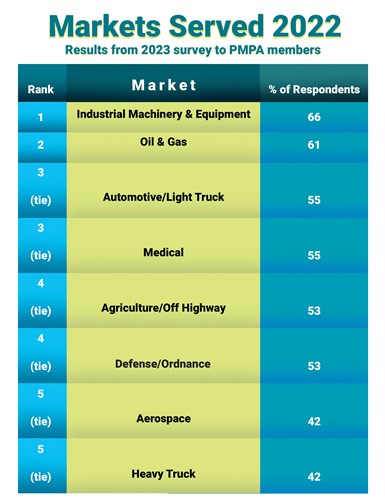Markets Served — Who Knew?
PMPA members shared the markets they served in 2022. The top 5 may surprise you.

Every year, the PMPA does a survey of our membership to determine the critical topics they are seeing as we prepare for our advocacy in Washington D.C. before Congress and working with executive branch agencies. This year’s survey showed continued high interest in many areas of concern, particularly around expensing, depreciation and recovering research and development investments. But the surprising takeaway for me was to see how the percentage of shops serving the various market segments has changed just since last year.
Historically, the top five markets most heavily served by our North American precision machining shops have been light vehicle, aerospace, medical device and implant, industrial machinery and equipment, and agricultural equipment/off highway. One of the interesting facts is that in many years, the category “all other” is often the third or fourth largest category — our shops’ high precision, high-performance components empower many different systems in a wide variety of industries. This year, “all other” came in eighth position showing just how strongly the demand from our primary markets has been.
This year’s surprise? Oil and gas customers were the second-place market served with 61% of survey respondents reporting sales to that industry. Industrial machinery and equipment came in first position, claiming shipments from 66% or two-thirds of respondents. Automotive light truck came in third position tied with medical with 55% of this year’s survey respondents producing parts for those industries.
Agriculture and off-road came in fourth place, tied with defense/ordnance at 53% of respondents producing for these industries. Aerospace, typically our shops number two or three industry in terms of being served by our shops, came in fifth position, tied with heavy truck which is served by half of our survey participants. Appliances, electronics, telecommunications,
new/renewable energy (think solar, wind, hydro)and computer/business machines filled the remainder of named markets served.
Every shop is different, and even though many shops use similar machine tools, equipment and technology, each organization has its own strengths and focus as far as understanding and meeting customer requirements — both explicit and implicit. But what the shifting number of shops serving each of these different markets showed me is that our shops also have a flexibility, an agility to meet the needs of the greater market. Yes, a shop may be a strong provider of high-volume, low-mix critical components for autos and light trucks, but that does not mean they cannot also be a supplier for a variety of other components in smaller quantities for other industries.
The greatest surprise to me, however, from this year’s survey results, was the strong showing of oil/gas as the market served by the second largest cohort of shops in our survey. I would never have thought that oil/gas — aka dinosaur juice, according to the pundits inside the beltway — would be the second most important market for our shops for contract parts production. And yet we are. This flies in the face of all of the policy and legislative initiatives for reducing CO2, climate change and ESG considerations in the federal government — I counted 54 separately listed entries in the Energy Information Administration’s Table 1 included and excluded Inflation Reduction Act (IRA) provisions in The Annual Energy Outlook 2023 publication.
Despite the reports and forecasts of energy-related CO2 emissions falling 25%-38% below 2005 levels, our shops are finding components for oil and gas to be the second largest segment of their current book of business. If we were to add the percentage of shops also claiming renewable and new energy production orders market, the percentage of shops serving “all energy” rises to number one position — with the largest number of our shops producing components.
Our takeaways? Despite all of the press attention on new and renewable energy, and CO2 reduction, the oil and gas market is surprisingly our industry’s second-ranked market served by percentage of shops responding. It is second to industrial machinery and equipment, ahead of automotive and light truck in third position, with medical and aerospace tying for fourth. This ranking is quite an upset. All of these markets are human-safety critical, where requirements for safety, quality and integrity of product are of the highest importance.
For the old timers who think our industry is just about hose fittings and high volumes of commodity parts, our latest survey tells a much different story. We are the people that make things. Things that provide all of us with energy. Energy that makes things go. Without energy there is no supply chain — nor need for one. Take the reports of the impending death of dino juice and ICE vehicles with a healthy dose of critical thinking. While these markets are expected to decline, our shops are currently finding plenty of opportunity to add value as they produce needed critical components. In the long term, our parts count and book of business could shrink. But we were completely surprised to see that the oil/gas market is, as of 2023, our second largest market served.
Read More Articles from PMPA:
- Roles of Women in Manufacturing Series: Human Resources — Brenda Diehl and Diane Ferrera
- Craftsman Cribsheet No.115: Paint Your Edge to Gain an Edge!
About the Author
Miles Free III
Miles Free III is the PMPA Director of Industry Affairs with over 40 years of experience in the areas of manufacturing, quality, and steelmaking. He helps answer “How?, “With what?” and “Really?” Miles’ blog is at pmpaspeakingofprecision.com; email – mfree@pmpa.org; website – pmpa.org
Related Content
Precision Ground Barstock: How It Is Manufactured, Benefits to Your Shop
Understanding the benefits provided by precision centerless ground barstock can help you avoid false economy and optimize the work you quote by maximizing benefits to your manufacturing process and customer.
Read MoreCraftsman Cribsheet No. 126: AISI System of Identification
Source: PMPA Prior to the Society of Automotive Engineers taking responsibility for Steel Grade nomenclature in the United States (1995), the American Iron and Steel Institute determined U.S. standard steel grades in collaboration with SAE.
Read MoreCraftsman Cribsheet No. 121: ISO Turning — What Does it All Mean?
How to make sense of all those different letters and numbers in ISO turning inserts.
Read MoreCold-Drawn Steel Barstock: How It Is Manufactured, Benefits to Your Shop
Understanding the benefits provided by cold-drawn steel barstock can help you optimize the work you quote by maximizing benefits to your manufacturing process and customer.
Read MoreRead Next
A Tooling Workshop Worth a Visit
Marubeni Citizen-Cincom’s tooling and accessory workshop offers a chance to learn more about ancillary devices that can boost machining efficiency and capability.
Read MoreDo You Have Single Points of Failure?
Plans need to be in place before a catastrophic event occurs.
Read More5 Aspects of PMTS I Appreciate
The three-day edition of the 2025 Precision Machining Technology Show kicks off at the start of April. I’ll be there, and here are some reasons why.
Read More













.jpg;maxWidth=300;quality=90)








